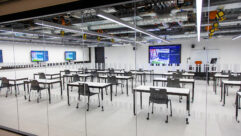Manchester, N.H.
Fewer projects are under way in Manchester these days, but the city’s focus on ensuring the economic viability of what gets built means fewer are in financial trouble.
Manchester, N.H.
Fewer projects are under way in Manchester these days, but the city’s focus on ensuring the economic viability of what gets built means fewer are in financial trouble.
Manchester, N.H.
Fewer projects are under way in Manchester these days, but the city’s focus on ensuring the economic viability of what gets built means fewer are in financial trouble.
- http://www.proavmagazine.com/Images/tmp32A1%2Etmp_tcm46-359603.jpgHillsborough County North Superior Court Architect Lavallee Brensinger Architects Manchester N.H. Completion 2011. Brief 13.7 million expansion and renovation of existing building to current court standards LEED Silver status pending.600Lavalle Brensinger ArchitectsHillsborough County North Superior Court
Architect: Lavallee Brensinger Architects, Manchester, N.H.Completion: 2011.
Brief: $13.7 million expansion and renovation of existing building to current court standards LEED Silver status pending.
- http://www.proavmagazine.com/Images/tmp32A2%2Etmp_tcm46-359612.jpgNew Hampshire Institute of Art Architect Dennis Mires The Architects Manchester. Completion 2009. Brief 7.3 million rehab of city’s first high school ca. 1891 includes dormitory and teaching spaces geothermal HVAC rainwater harvesting and vegetated roof.600Dennis MiresNew Hampshire Institute of Art
Architect: Dennis Mires, The Architects, Manchester.Completion: 2009.
Brief: $7.3 million rehab of city’s first high school (ca. 1891) includes dormitory and teaching spaces, geothermal, HVAC, rainwater harvesting, and vegetated roof.
- http://www.proavmagazine.com/Images/tmp32A3%2Etmp_tcm46-359621.jpgPandora Mill Architect John S. Jordan Design Canterbury N.H. Completion 2010. Brief 11 million redevelopment of a historic mill into a LEED Silver pending office building.600Althea Haropulos PhotographersPandora Mill
Architect: John S. Jordan Design, Canterbury, N.H.Completion: 2010.
Brief: $11 million redevelopment of a historic mill into a LEED Silver pending office building.
- http://www.proavmagazine.com/Images/tmp32A4%2Etmp_tcm46-359630.jpgRivers Edge Architect Cube 3 Studio Lawrence Mass. Completion 2011. Brief Project includes a 238000s.f. ambulatory care center and a 125000s.f. medical office building phase 1 105 million remaining phases 63.7 million.600Cube 3 StudioRivers Edge
Architect: Cube 3 Studio, Lawrence, Mass.
Completion: 2011.
Brief: Project includes a 238,000-s.f. ambulatory care center and a 125,000-s.f. medical office building; phase 1: $105 million; remaining phases: $63.7 million.
1 of 1
Get the link to this image:Copy
Chartered as Derryfield in 1751, a decade after New Hampshire separated from Massachusetts, the small town at the Amoskeag Falls on the Merrimack River was renamed in 1810 after Manchester, England, the first industrialized city. As a manufacturing center—it was home to, among other businesses, Mill No. 11, the largest cotton mill in the world—the city attracted immigrants from around the globe. Even today, 70 languages are spoken in the local school district.
Manchester’s industrial roots remain evident in the city’s Victorian-style mill buildings, but its economy has moved away from manufacturing. As the largest city north of Boston, and with a central location in northern New England, Manchester has become a regional healthcare and education hub. In 2009, CNNMoney.com ranked it the 13th best U.S. city to live and launch a business in, and Kiplinger named it the nation’s second-most-tax-friendly city.
The recession has slowed development somewhat, but for the most part, the city has fared well during the downturn. “I think it is in part due to our [economic] diversity and Yankee conservatism,” says Chris Wellington, a marketing specialist in the city’s economic development office. Manchester officials urge public-private partnerships to fund large developments, keeping most projects—such as the multiphase River’s Edge development—manageable and on track.
“In order for development to happen, it must be a project that can stand on its own financially,” notes Barry Brensinger, CEO of local firm Lavallee Brensinger Architects. “That can be a good thing, but it’s a challenge right now.” With all levels of government cutting back, fewer projects are under way. But there also are fewer in financial trouble, meaning that “ManchVegas,” as locals call it, has largely avoided the fate of Las Vegas and other cities that saw numerous speculative developments die on the vine.
POPULATION/EMPLOYMENT
2009 population: 110,000, with 73,389 employed in-town.
OFFICE MARKET
February 2010 vacancy: 17.7%; average asking rate: $16.84/s.f.
RESIDENTIAL MARKET
Median home sale price, December 2009: $208,000.
MARKET STRENGTHS
• Proximity to New England hub cities
• No sales or income tax
• Educated workforce
MARKET CONCERNS
• Depressed housing market
• Potential glut of commercial space
• General economic malaise
FORECAST
“Manchester has a lot of self-confidence, despite the times,” says Lavallee Brensinger Architects’ Barry Brensinger. “Improvements bring confidence in the future, and there’s a general sense of optimism. A number of people are working on some interesting projects.”










